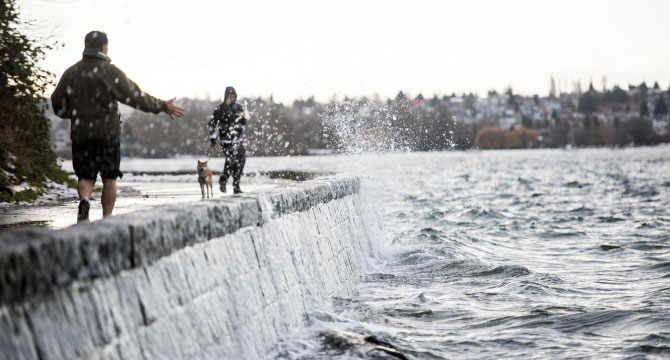
 Council approves directions for the Healthy Waters Plan
Council approves directions for the Healthy Waters Plan
Today, Council unanimously approved the key directions for the Healthy Waters Plan PDF file (50 KB) that will guide long-range sewage and rainwater management in Vancouver. The recommendations include a shift for the City that will help manage the pace and financial impacts of sewer infrastructure investments, achieve better water quality outcomes and help address climate change impacts like flooding.
The Healthy Waters Plan aims to ramp-up efforts on the elimination of combined sewer overflows (CSOs) through a more targeted and strategic approach to sewer separation. The plan also recommends expansion of green rainwater infrastructure (GRI) and natural areas to remove pollutants from rainwater runoff and help communities adapt to a changing climate.
When rain lands in cities, it picks up chemicals and other pollutants. Without intervention, rainwater pollution and flooding are expected to worsen over time. Population growth, larger buildings that decrease the ground surface that is able to absorb rainwater, and more intense rainfall from climate change – are all drivers. Redirecting rainwater away from the sewer system is also essential for maintaining system capacity and eliminating CSOs.
“Vancouver is a growing city with ageing infrastructure, and that comes with many challenges,” said Mayor Ken Sim. “The Healthy Waters Plan is a smart, cost-effective way to support new housing, upgrade our infrastructure, improve water quality, and tackle climate pressures all at once. It’s about thinking differently, finding creative solutions, and delivering real benefits for Vancouverites.”
The key directions for the plan are:
- Adopt an enhanced approach to sewer separation that prioritizes protecting downstream waterbodies like Burrard Inlet, and more rapidly removing rainwater, groundwater and buried creeks from sewer systems in the city.
- Expand GRI and natural areas on City land using absorbent landscaping to clean and reduce the volume of rainwater entering sewers while reducing urban heat, improving air quality, creating habitat and food for different species, making Vancouver more liveable and more sustainable. Local monitoring of GRI found that 99% of harmful sediment and certain chemicals – like 6 PPD quinone which can kill salmon – are removed by the City’s GRI. (Source: COV GRI Performance Monitoring Report PDF file (19 MB)).
- Optimize rainwater management policy for redevelopment to minimize growth-driven costs, as well as flooding and CSO risks. Solutions include expanded use of tank-based approaches, with considerations for enabling rainwater to be used for non-potable water use as well as infiltrating rainwater into the ground.
Staff recommendations were developed following an intense engagement process that included xʷməθkʷəy̓əm (Musqueam Indian Band), Sḵwx̱wú7mesh Úxwumixw(Squamish Nation), and səlilwətaɬ(Tsleil-Waututh Nation), Metro Vancouver, senior government representatives and relevant environmental and community groups.